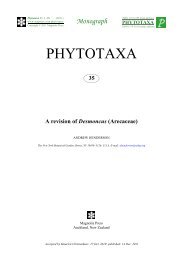Zootaxa, Taxonomy of Serpulidae (Annelida ... - Magnolia Press
Zootaxa, Taxonomy of Serpulidae (Annelida ... - Magnolia Press
Zootaxa, Taxonomy of Serpulidae (Annelida ... - Magnolia Press
Create successful ePaper yourself
Turn your PDF publications into a flip-book with our unique Google optimized e-Paper software.
normal radiole and maximally covering base <strong>of</strong> first three radioles. Pseudoperculum absent. Radioles arranged<br />
in semi-circles, up to 24 per lobe; inter-radiolar membrane, branchial eyes, and stylodes absent. Mouth palps<br />
present. 6 thoracic chaetigerous segments. Collar tri- to penta-lobed, collar edge may be almost laciniate;<br />
tonguelets between ventral and lateral collar lobes present. Thoracic membranes long, forming ventral apron<br />
across anterior abdominal segment. Collar chaetae absent; collar region with girdle <strong>of</strong> reddish ocelli.<br />
Apomatus chaetae absent. All uncini sub-rectangular, rasp-shaped with > 20 teeth in pr<strong>of</strong>ile, and up to 8 small<br />
teeth in a row; anterior peg wide, flat, bluntly truncate, almost rectangular (Fig. 34A). Thoracic triangular<br />
depression absent. Abdominal chaetae truly trumpet, with distal hollow triangular blade, abruptly bent (Fig.<br />
34C). Achaetous anterior abdominal zone present. Long posterior capillary chaetae may be present. Posterior<br />
glandular pad absent.<br />
Remarks. Placostegus is one <strong>of</strong> three serpulid genera (see also Neomicrorbis and Vitreotubus) with an<br />
entirely vitreous tube; completely transparent, glass-like in live animals, it may become milky-white semitransparent<br />
after preservation in formalin. The tube in P. incomptus shows a remarkable dual appearance,<br />
proximally with closely set transverse ribs, distally smoothly triangular. Fauvel (1927 fig. 128i) and Imajima<br />
(1978 fig. 9c) mention a chitinous talon projecting from the endplate into the opercular bulb.<br />
Placostegus has one evident diagnostic autapomorphy—the belt <strong>of</strong> bright red ocelli in the region where in<br />
other genera collar-chaetae are found (e.g., Langerhans 1884 fig. 38b, Ehlers 1887 fig. 3, Hartman 1969 fig. 2;<br />
our Fig. 1F).<br />
1. Placostegus assimilis McIntosh, 1885, <strong>of</strong>f Bermudas; bathyal<br />
2. Placostegus californicus Hartman, 1969, Southern California<br />
3. Placostegus crystallinus (Scacchi, 1836) sensu Zibrowius, 1968a, Eastern North Atlantic, Mediterranean;<br />
?Red Sea, Indian Ocean, these reports might belong to a different species (Ben-Eliahu, pers. comm.)<br />
4. ? Placostegus grayi Baird, 1865, no location given; generic status uncertain<br />
5. Placostegus incomptus Ehlers, 1887, <strong>of</strong>f Cuba; bathyal<br />
6. Placostegus langerhansi Marenzeller, 1893, Madeira, Canary Islands<br />
7. Placostegus tridentatus (Fabricius, 1780), Atlantic, Mediterranean, Indo-West Pacific.<br />
30. Pomatoceros Philippi, 1844<br />
(Fig. 35)<br />
Type-species: Serpula triquetra Linnaeus, 1758<br />
Number <strong>of</strong> species: 5<br />
Tube generally white, opaque, though blue, purplish and pink parts may occur; usually with longitudinal<br />
keel(s), may be with more or less regular series <strong>of</strong> pits, triangular or sub-triangular in cross-section; granular<br />
overlay absent. Operculum with inverse conical to rather shallow ampulla, with calcified endplate, sometimes<br />
bearing spines. Peduncle thick, triangular in cross-section, with distal lateral wings; a constriction between<br />
peduncle and ampulla may be present; peduncle inserted almost medio-dorsally, covering the base <strong>of</strong> up to<br />
three dorsal radioles. Pseudoperculum absent. Radioles arranged in semi-circles and up to 20 per lobe.<br />
Branchial eyes and stylodes absent. Mouth palps present. 7 thoracic chaetigerous segments. Collar trilobed;<br />
tonguelets between ventral and lateral collar lobes present. Thoracic membranes long, forming ventral apron<br />
across anterior abdominal segment. Collar chaetae small, limbate. Apomatus chaetae absent. All uncini sawshaped<br />
with 10–11 teeth, anterior peg blunt gouged (Fig. 35A, B). Thoracic triangular depression present.<br />
Abdominal chaetae true trumpet-shaped, abruptly bent, distally with two rows <strong>of</strong> denticles separated by<br />
hollow groove (Fig. 35C, D). Achaetous anterior abdominal zone absent. Long posterior capillary chaetae<br />
absent. Posterior glandular pad absent.<br />
Remarks. See remarks for Spirobranchus.<br />
TAXONOMY OF SERPULIDS: STATE OF AFFAIRS<br />
<strong>Zootaxa</strong> 2036 © 2009 <strong>Magnolia</strong> <strong>Press</strong> · 75
















